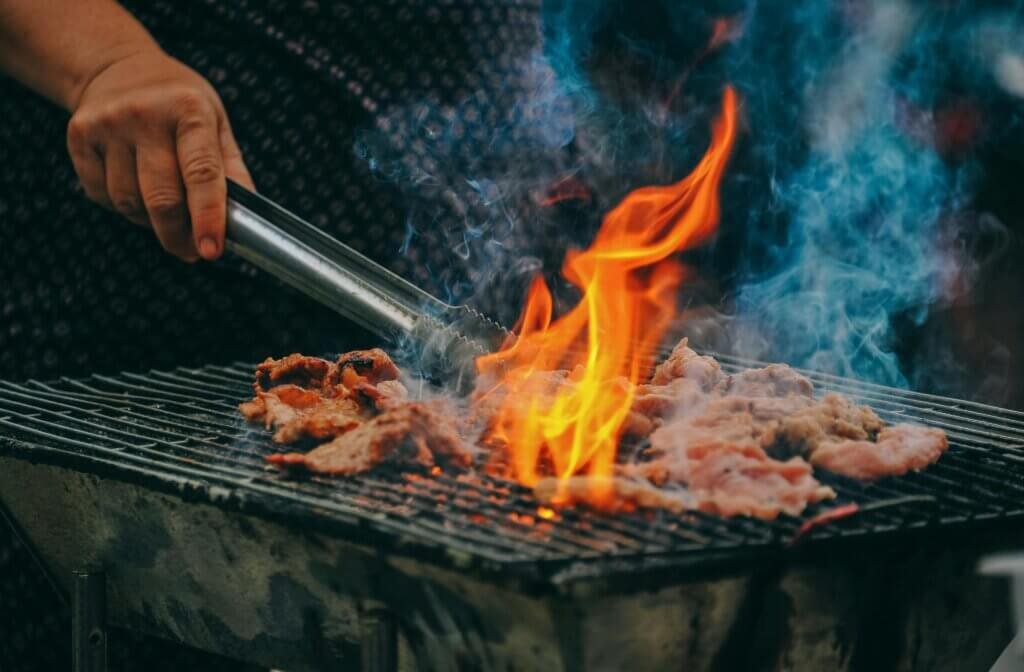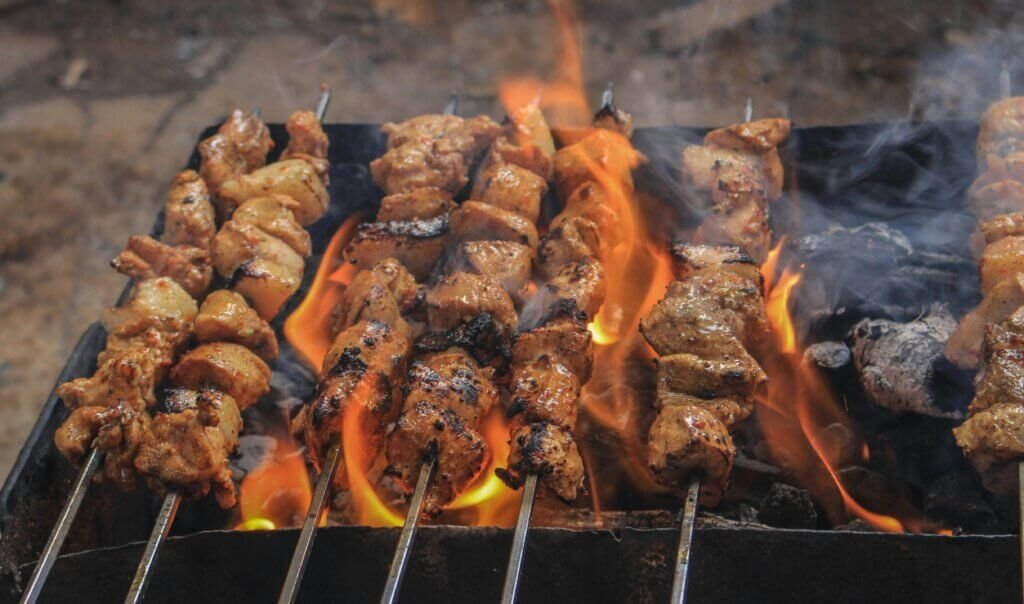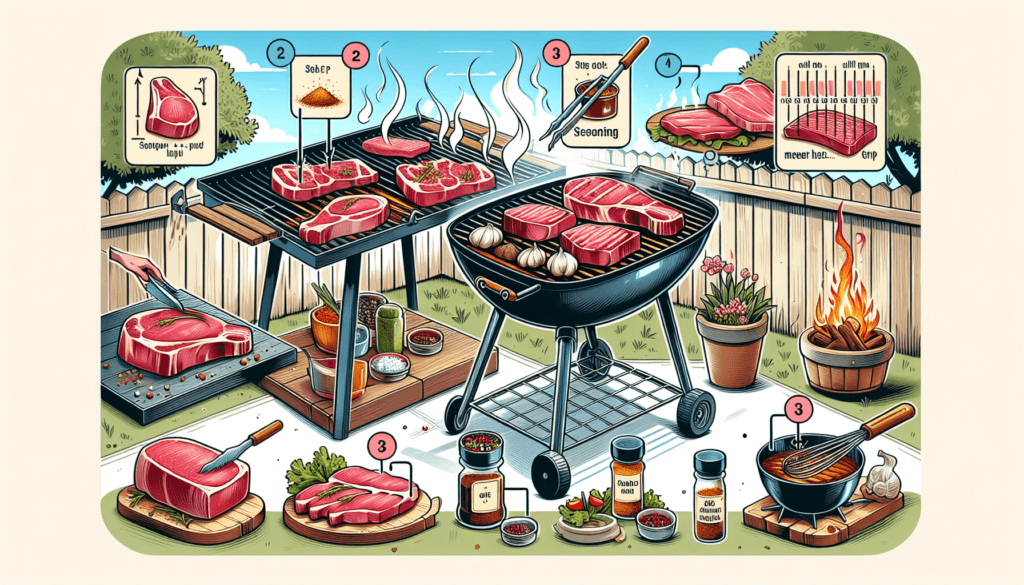Get ready to elevate your grilling game and take your taste buds on a flavorful journey with this article on how to properly grill and sear meats for maximum flavor. Whether you’re a seasoned grill master or a beginner looking to expand your culinary skills, these tips and techniques will help you achieve that perfect juicy and charred result every time. From choosing the right cuts of meat to mastering the art of searing, you’ll learn all the tricks of the trade to make your grilled meats the star of any meal. So fire up the grill, grab your apron, and get ready to impress your family and friends with mouthwatering flavors that will have them coming back for seconds.

Choosing the Right Cut of Meat
When it comes to grilling and searing meats, choosing the right cut is crucial. Different cuts have different characteristics that can greatly affect the taste and texture of the final product. There are a few key factors to consider when selecting the perfect cut of meat for your grilling adventure.
Consider the Fat Content
One important consideration when choosing a cut of meat is the fat content. Fat plays a crucial role in adding flavor and juiciness to grilled meats. It helps to keep the meat moist during cooking and contributes to the overall taste. If you prefer a leaner meat, opt for cuts with less visible fat. However, keep in mind that a higher fat content usually means more flavor and tenderness.
Look for Marbling
Marbling refers to the visible streaks of fat that are distributed throughout the meat. This intramuscular fat not only adds flavor but also helps to keep the meat moist during the cooking process. When selecting a cut of meat, look for generous marbling, as it is a good indicator of tenderness and juiciness. The fat will render during cooking and infuse the meat with delicious flavor.
Opt for Thicker Cuts
When grilling or searing, it is generally recommended to choose thicker cuts of meat. Thicker cuts have a better chance of retaining moisture and tenderizing properly. Thicker cuts also provide more room for error, as they are less likely to overcook quickly. In addition, thicker cuts are more forgiving when it comes to achieving the perfect level of doneness, allowing you to avoid serving dry or overcooked meat.
Preparing the Meat
Before you start grilling, it’s important to properly prepare the meat. Taking a few extra steps can greatly enhance the taste and texture of your grilled or seared meat.
Trim Excess Fat
While fat adds flavor and juiciness, excessive amounts of fat can lead to flare-ups and charred meat. To prevent this, it’s essential to trim any excess fat from the meat. Use a sharp knife to carefully remove any thick pieces of fat, but be mindful not to remove too much, as a moderate amount of fat is important for flavor and moisture.
Bring Meat to Room Temperature
To ensure even cooking, it’s recommended to bring the meat to room temperature before grilling or searing. Allowing the meat to sit at room temperature for about 30 minutes to an hour before cooking will help to achieve more consistent results. This step ensures that the meat cooks evenly, preventing any potential overcooking of the external layers while the center is still raw.
Seasoning the Meat
Seasoning is an essential step in enhancing the flavor of grilled and seared meats. Prior to cooking, generously season the meat with your preferred combination of spices, herbs, and seasoning blends. Be sure to thoroughly coat the meat on all sides to ensure an even distribution of flavor. Let the seasoned meat sit for a few minutes to allow the flavors to penetrate before cooking.
Preheating and Cleaning the Grill
A properly preheated and clean grill is crucial for achieving optimal grilling and searing results. It ensures even heat distribution and minimizes the risk of sticking or charring.
Start with a Clean Grill
Before each grilling session, it’s essential to thoroughly clean the grill grates. Scrub the grates with a grill brush to remove any residue or stuck-on food from previous grilling sessions. This step not only helps to prevent any unwanted flavors but also ensures that the meat cooks evenly and doesn’t stick to the grates.
Preheat the Grill
To achieve the perfect sear and grill marks, it’s important to preheat the grill before cooking. Turn on the grill to high heat and close the lid. Allow the grill to reach the desired temperature, which is typically around 400-450 degrees Fahrenheit. Preheating the grill ensures that the meat cooks quickly and achieves a beautiful caramelized crust while remaining tender and juicy on the inside.
Oil the Grill Grates
To prevent the meat from sticking to the grill grates, it’s important to properly oil them before cooking. Using tongs and a paper towel soaked in high smoke point oil, carefully oil the grates. This creates a non-stick surface and helps to achieve those desirable grill marks. Be cautious when oiling the grates, as excess oil can cause flare-ups and potentially char the meat.
Direct vs Indirect Grilling
Understanding the difference between direct and indirect grilling is important for determining the cooking method that suits your meat best.
Understanding the Difference
Direct grilling involves placing the meat directly over the heat source, resulting in quick and intense cooking. This method is perfect for smaller cuts of meat or those that are already tender and don’t require a prolonged cooking time. Indirect grilling, on the other hand, involves cooking the meat adjacent to the heat source rather than directly above it. This method allows for slower and more gentle cooking, ideal for larger cuts of meat that require longer cooking times to become tender.
Choosing the Right Method for Your Meat
When deciding whether to use direct or indirect grilling, consider the size and thickness of the meat, as well as its desired level of doneness. Thinner cuts, such as steaks or burgers, can be cooked using direct grilling for a quick sear. Thicker cuts, such as roasts or whole chickens, benefit from indirect grilling to ensure even cooking throughout. Understanding the needs of your meat will help you choose the appropriate grilling method for the best results.

Searing the Meat
Searing is a technique that helps to lock in the juices and create a flavorful crust on the outside of the meat. While searing is often associated with beef steaks, it can be applied to various types of meat to enhance their flavor and texture.
Preheat a Skillet or Cast Iron Pan
To achieve a proper sear, it’s important to preheat a skillet or cast iron pan before adding the meat. Place the pan over high heat and allow it to get hot. This ensures that the meat sears quickly and evenly, creating a desirable crust on the outside while keeping the interior juicy and tender.
Coat with High Smoke Point Oil
Before adding the meat to the hot pan, coat it with a high smoke point oil to prevent sticking and promote a crisp sear. Oils such as canola, vegetable, or peanut oil are commonly used for searing due to their high smoke points. Gently brush or rub the oil onto the surface of the meat to ensure an even distribution.
Get a Golden Brown Crust
Once the skillet or cast iron pan is hot and the meat is coated with oil, carefully place the meat into the pan. Allow it to sear undisturbed for a few minutes, depending on the thickness of the cut and desired level of browning. Flip the meat to sear the other side, repeating the process until a golden brown crust has formed. Searing the meat adds depth of flavor and enhances the overall visual appeal of the dish.
Grilling the Meat
Grilling meat to perfection requires proper temperature control and careful attention to cooking times. Following these guidelines will help you achieve optimal results every time.
Adjusting Grill Temperature
Maintaining the right grill temperature is crucial for successful grilling. Different cuts of meat require different levels of heat. For thicker cuts, it’s recommended to use medium-high heat, whereas thinner cuts benefit from high heat. By adjusting the grill temperature accordingly, you can ensure that the meat cooks evenly and achieves the desired level of doneness.
Placing the Meat on the Grill
When placing the meat on the grill, it’s essential to arrange it in a way that maximizes heat distribution and prevents hotspots. Leave enough space between each piece of meat to allow for proper air circulation. Avoid overcrowding the grill, as this can cause uneven cooking and potentially lead to overcooked or undercooked areas. By positioning the meat properly, you’ll achieve more consistent results.
Monitor and Adjust Cooking Time
Meat continues to cook even after it’s been removed from the heat source, so it’s important to keep a close eye on cooking times to avoid overcooking. Use a meat thermometer to monitor the internal temperature of the meat and determine its doneness. Follow a grilling guide or recipe for recommended cooking times, but always rely on the thermometer for accurate results. Adjust the cooking time as needed to ensure that the meat is cooked to perfection.

Using Marinades and Rubs
Marinades and rubs are invaluable tools for infusing flavor into grilled and seared meats. By using the proper techniques, you can take your grilled dishes to the next level.
Benefits of Marinades and Rubs
Marinades and rubs not only enhance the flavor of the meat but also help to tenderize and moisten it. Marinating meat involves soaking it in a flavorful mixture, typically consisting of acids, such as vinegar or citrus juice, combined with oil and various spices. This allows the flavors to penetrate the meat, resulting in a more flavorful and succulent end product. Rubs, on the other hand, are dry mixtures of spices, herbs, and seasonings that are applied directly to the surface of the meat. Rubs create a flavorful crust and can be used to add depth to the taste.
Proper Application and Timing
When using marinades, make sure to fully submerge the meat in the liquid and seal it in an airtight container. Allow the meat to marinate in the refrigerator for the recommended amount of time, which varies depending on the type and cut of meat. For rubs, generously apply the mixture to all sides of the meat and let it sit for a while before grilling or searing. This allows the flavors to develop and penetrate the meat for maximum taste.
Avoid Excessive Salt Content
While salt is an important seasoning, it’s crucial to avoid excessive salt content in marinades and rubs. Too much salt can result in an overly salty final product. Use salt sparingly and consider other flavor-enhancing ingredients, such as herbs, spices, and acids. Experiment with different combinations to find the perfect balance of flavors that complements the natural taste of the meat.
Handling and Resting the Meat
Properly handling and resting the meat after grilling or searing is essential for preserving its taste and tenderness.
Using Tongs or Spatula
When handling the meat on the grill, it’s important to use the proper utensils to avoid piercing or tearing it. Opt for long-handled tongs or a spatula specifically designed for grilling. These tools will allow you to easily flip and maneuver the meat without causing any damage or disrupting the cooking process.
Allowing the Meat to Rest
Resting the meat after grilling or searing is a crucial step that allows the juices to redistribute and the meat to relax. Remove the meat from the grill and let it sit on a cutting board or a platter for a few minutes before carving or serving. This resting period ensures that the moisture is evenly distributed throughout the meat, resulting in a juicier and more flavorful final product.
Covering and Carving
While the meat is resting, you can cover it loosely with aluminum foil to keep it warm. This will also help retain some of the heat and further redistribute the juices. When carving the meat, make sure to use a sharp knife and cut against the grain to achieve maximum tenderness. By following these steps, you can ensure that the meat remains succulent and delicious from the first bite to the last.

Determining Meat Doneness
Achieving the desired level of doneness is an important aspect of grilling and searing meats. The following methods can help you determine the doneness of your meat.
Using a Meat Thermometer
Using a meat thermometer is the most accurate way to determine the internal temperature and doneness of the meat. Different types of meat have different recommended internal temperatures for various levels of doneness. Insert the thermometer into the thickest part of the meat, away from any bones, and wait for the temperature reading to stabilize. This will provide you with an accurate gauge of the meat’s doneness.
Learn the Touch Test
For those who prefer a more intuitive approach, the touch test can also be used to determine the doneness of the meat. This method involves comparing the firmness of the meat to different parts of your hand. For example, gently press the palm of your hand and compare it to the meat. The firmness and texture should be similar to achieve the desired level of doneness. This method requires practice and experience to master, but it can be a useful tool for grillers who prefer a more hands-on approach.
Avoid Overcooking
Overcooking can result in dry, tough meat that lacks flavor. It’s always better to slightly undercook the meat and allow it to rest, as it will continue to cook during the resting period. By avoiding overcooking, you can ensure that the meat retains its natural juiciness and tenderness, creating a more enjoyable dining experience.
Serving and Enjoying the Grilled Meat
After putting in the effort to grill or sear your meat to perfection, it’s time to savor the flavors and enjoy the fruits of your labor.
Garnishing and Presentation
When plating the grilled meat, consider adding some garnishes to elevate the visual appeal of the dish. Fresh herbs, such as parsley or cilantro, can be sprinkled on top to add a pop of color. Additionally, consider serving the meat on a decorative platter or wooden cutting board to enhance the presentation. Taking these extra steps can make your grilled or seared meat look as good as it tastes.
Pairing with Appropriate Sauces
Choosing the right sauce or condiment can further enhance the flavor of the grilled meat. Consider pairing your meat with appropriate sauces, such as a tangy barbecue sauce for ribs or a zesty chimichurri sauce for steak. Condiments like flavored butter or a dollop of homemade aioli can also add an extra layer of richness and flavor. Experiment with different combinations to find the perfect sauce that complements the taste of your grilled masterpiece.
Savoring the Flavors
Finally, take the time to savor and enjoy every bite of your perfectly grilled or seared meat. Appreciate the flavors and textures that you have achieved through your cooking skills. Whether you’re enjoying a juicy steak or a tender chicken breast, savoring the flavors is the ultimate reward for a well-executed grilling or searing experience.
In conclusion, grilling and searing meats can be a truly enjoyable and rewarding experience. By carefully choosing the right cut of meat, properly preparing it, preheating and cleaning the grill, understanding the different grilling methods, searing the meat, and following proper grilling techniques, you can create delicious and flavorful dishes every time. Remember to utilize marinades and rubs to enhance the taste, handle and rest the meat properly, determine the doneness accurately, and finish off by serving and savoring the perfectly grilled or seared meat. So fire up the grill, gather your favorite meats, and get ready to embark on a culinary adventure that will leave your taste buds craving more. Happy grilling!



